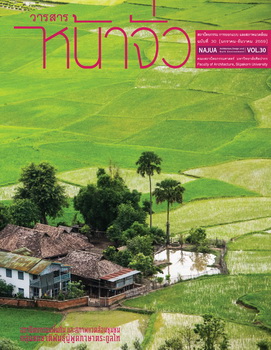ปริทัศน์การศึกษาว่าด้วย “พระเจดีย์ทรงดอกบัวตูม”
Keywords:
ภูมิทัศน์เมืองประวัติศาสตร์, ภูมิทัศน์ย่านประวัติศาสตร์, ยูเนสโก, Phra Chedi Dok Bua Toom, Phra Chedi Song Tanan, Phra Chedi Song Pum Kao Bin, Suhothai Art and ArchitectureAbstract
รูปแบบเจดีย์อันเป็นเอกลักษณ์ในศิลปสถาปัตยกรรมสุโขทัย มีชื่อเรียกกันหลายชื่อว่า “พระเจดีย์ทรงทนาฬ” “พระเจดีย์ทรงพุ่มข้าวบิณฑ์” และ “พระเจดีย์ทรงดอกบัวตูม” ซึ่งชื่อดังกล่าวนั้นเรียกขึ้นจากรูปทรงทางสถาปัตยกรรมส่วนของเรือนยอดของเจดีย์ที่มีลักษณะเป็น “ทรงพุ่มแบบดอกบัว”
จากรูปทรงทางสถาปัตยกรรมนั้นสะท้อนให้เห็นถึงการผสมผสานกันระหว่างแรงบันดาลใจจากปราสาทแบบเขมรที่สร้างอย่างแพร่หลายมาแต่เดิม และพระเจดีย์แบบมอญ จนกลายออกมาเป็นรูปทรงอันเป็นเอกลักษณ์เฉพาะตัวของศิลปสถาปัตยกรรมสมัยสุโขทัย
สถานภาพของข้อสันนิษฐานในปัจจุบันเสนอว่า เจดีย์รูปแบบนี้สร้างขึ้นเป็นครั้งแรกในรัชกาลพระมหาธรรมราชาลิไทย โดยหลักฐานบ่งชี้ที่เก่าแก่ที่สุด คือ จารึกนครชุม เมืองกำแพงเพชร ที่ระบุถึงการสร้างเจดีย์ของวัดในปี พ.ศ. 1900 รวมไปถึงมีการเผยแพร่รูปแบบไปยังเชียงใหม่ผ่านการเผยแผ่พระพุทธศาสนาจากสุโขทัยโดยพระสุมนเถระ โดยมีการสร้างเป็นพระเจดีย์บริวารทรงดอกบัวตูในราว พ.ศ.1914 ทั้งนี้ พระเจดีย์ทรงดอกบัวตูมมีความนิยมในการก่อสร้างต่อเนื่องมาจนกระทั่งกลางพุทธศตวรรษที่ 20 ดังปรากกฎกล่าวถึงในจารึกวัดอโสการาม
Review Article
Reviewing the Lotus-Bud Style Chedi
Kreangkrai Kirdsiri
Department of Architecture, Faculty of Architecture, Silpakorn University
Lotus-bud style, or Tanan style chedi, is an outstanding feature of Sukhothai architecture in which the upper part of the structure has the shape of a lotus-bud. The form was evidently inspired by Khmer style prasats, which were prevalent earlier, in combination with Mon style chedis. As a result, the style gave Sukhothai architecture its identity. A scripture found at Wat Nakhon Chum, Kamphaengphet Province, which mentioned about the construction of a chedi in 1357, led to the speculation that this style of architecture was first built in the period of Phra Mahadhammaraja Lithai. It was also introduced to Chiang Mai through Phra Sumana Dhera who was spreading the Buddhist religion at the time when chedis of this style were erected there in 1371, as minor stupas. According to the Scripture of Wat Asokaram, chedis in this style later became widespread and commonly constructed until mid-twentieth century B.E.





